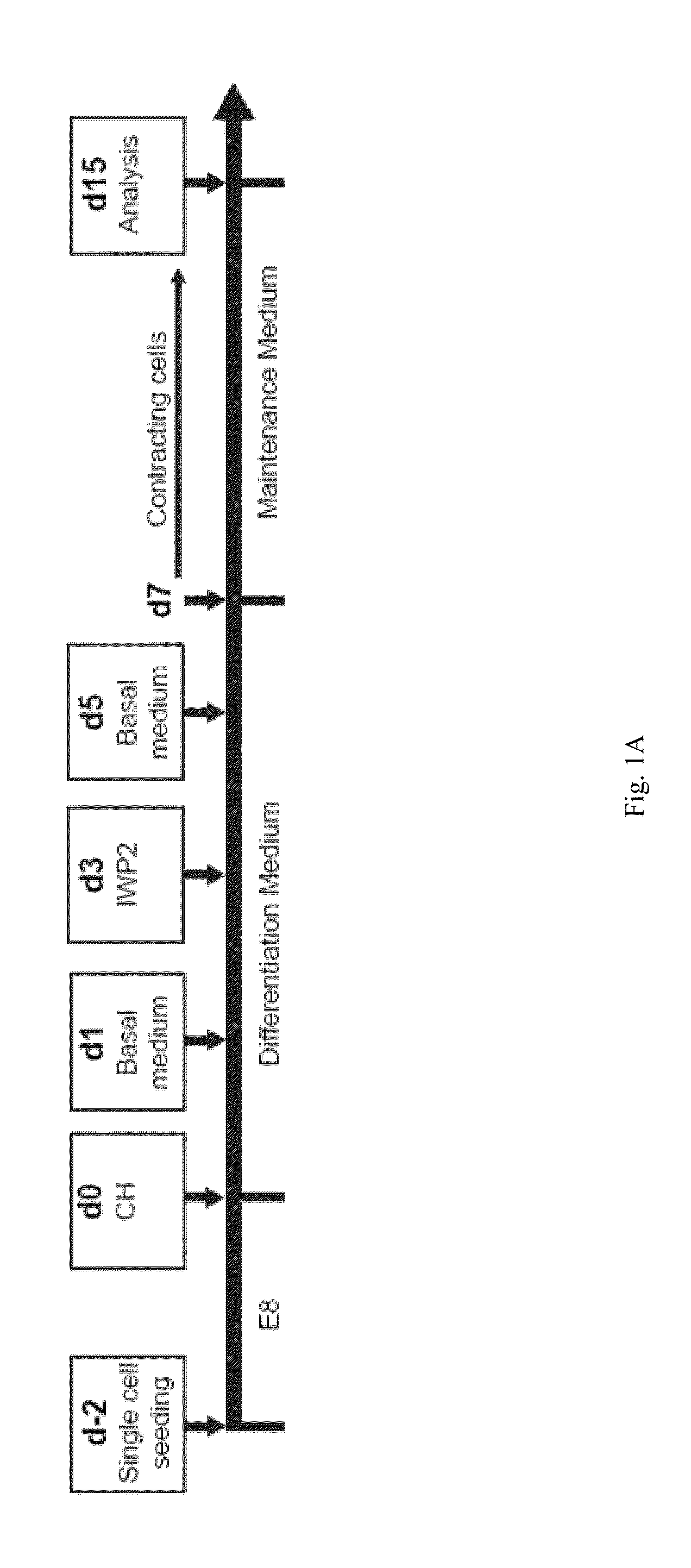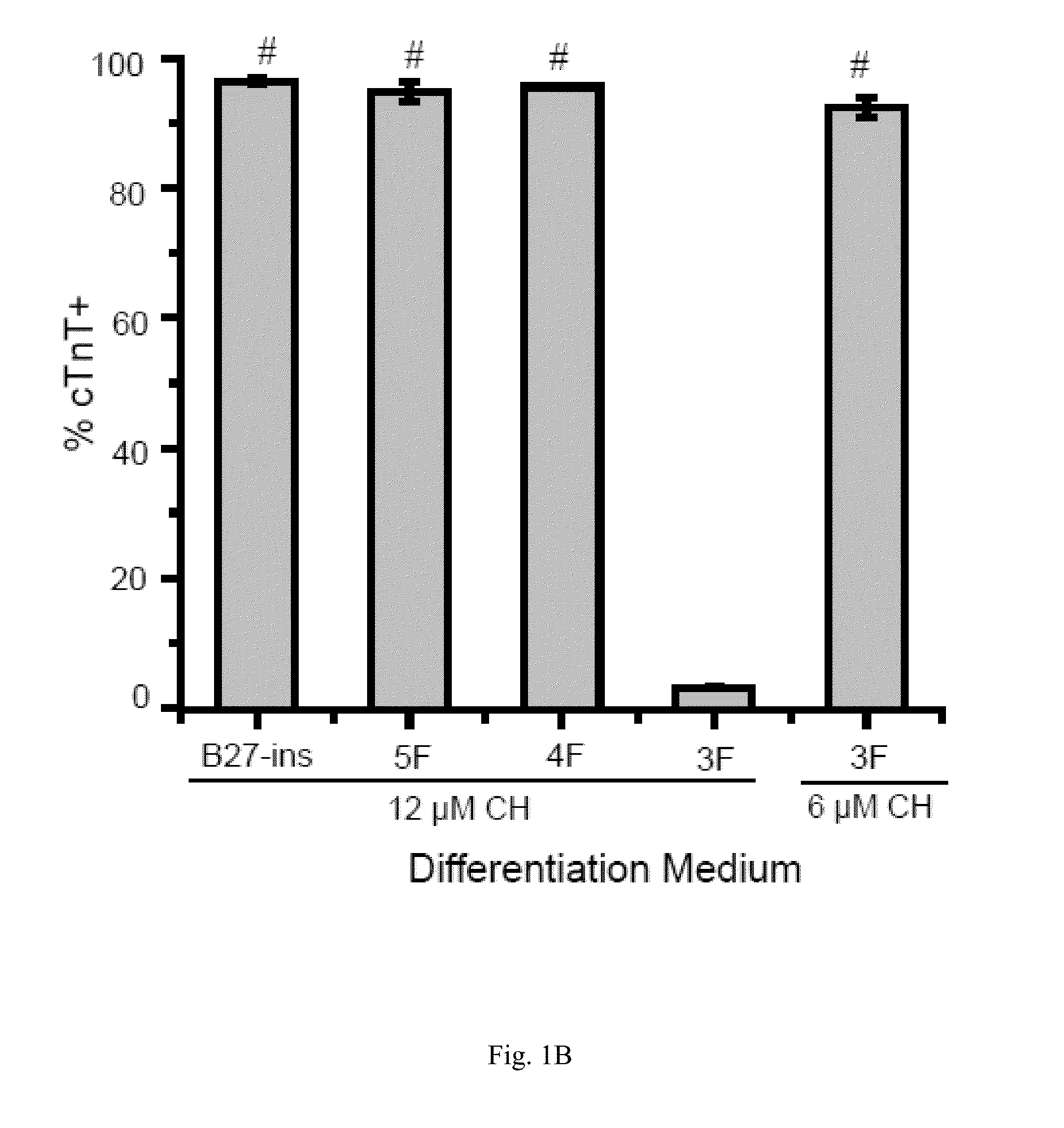Chemically defined albumin-free conditions for cardiomyocyte differentiation of human pluripotent stem cells
a technology albumin-free conditions, which is applied in the field of chemically defined albumin-free conditions for cardiomyocyte differentiation of human pluripotent stem cells, can solve the problems of limiting the potential of large-scale cardiomyocyte production of the protocol, increasing the cost, and limiting the application of large-scale cardiomyocyte production for therapeutic applications
- Summary
- Abstract
- Description
- Claims
- Application Information
AI Technical Summary
Benefits of technology
Problems solved by technology
Method used
Image
Examples
example 1
Albumin-Free hPSC Differentiation to Cardiomyocytes
[0095]Abstract.
[0096]In this Example, we describe a minimum differentiation system that employs small molecules to modulate Wnt activity but lacks serum albumin, which negatively affects Gsk3 inhibitor activity. Using this simple, defined platform, we demonstrate efficient, robust, and cost-effective cardiomyocyte differentiation, an important step toward large scale production of human cardiomyocytes for research and clinical applications.
[0097]General Procedures and Results.
[0098]Bovine Serum Albumin (BSA) is present in the RPMI / B27-ins (B27 without insulin supplement) cardiac differentiation medium used in the GiWi method that we previously disclosed in U.S. Patent Publication No. 2013 / 0189785 (FIG. 1A). We have now simplified our GiWi protocol and developed an albumin-free cardiomyocyte differentiation platform.
[0099]First, we compared B27-ins with other published recipes for cardiomyocyte differentiation (Burridge, P. W. et al....
example 2
Detailed Materials and Methods for Example 1
[0113]In this Example, we provide a detailed description of the materials and methods used in the studies described in Example 1 above.
[0114]Methods.
[0115]Maintenance of hPSCs. hESCs (ES03, H1, H9 (Thomson, J. A. et al. Embryonic stem cell lines derived from human blastocysts. Science 282, 1145-7 (1998)), HS181 (Ström, S. et al. Derivation of 30 human embryonic stem cell lines-improving the quality. In Vitro Cell. Dev. Biol. Anim. 46, 337-44 (2010))) and human iPSCs (19-9-7 (Yu, J. et al. Human induced pluripotent stem cells free of vector and transgene sequences. Science 324, 797-801 (2009)), 19-9-11 (Yu, J. et al. Human induced pluripotent stem cells free of vector and transgene sequences. Science 324, 797-801 (2009)), 6-9-9 (Yu, J. et al. Human induced pluripotent stem cells free of vector and transgene sequences. Science 324, 797-801 (2009)), IMR90C4 (Yu, J. et al. Induced pluripotent stem cell lines derived from human somatic cells. S...
example 3
Inhibiting Signaling Immediately After Activating Signaling
[0123]In this Example, we demonstrate that the step of inhibiting Wnt / β-catenin signaling may be performed immediately after the step of activating Wnt / β-catenin signaling. No intervening “rest” period, during which no Wnt / β-catenin signaling activation or inhibition takes place, is required to successfully differentiate cardiomyocytes using the disclosed protocol.
[0124]Referring to FIG. 8, the right column shows cardiomyocyte differentiation (as determined by flow cytometry analysis of cTnT expression on day 15) for cells derived from hPSCs in albumin-free media using the GiWi protocol outlined in Examples 1 and 2, using the timeline shown in FIG. 1A. Specifically this protocol included an intervening “rest” period between Gsk inhibition by CH, which occurred on days 0-1, and porcupine inhibition by IWP2, which occurred on days 3-5. During the intervening “rest” period (days 1-3), cells were cultured in the basal medium in ...
PUM
 Login to View More
Login to View More Abstract
Description
Claims
Application Information
 Login to View More
Login to View More - R&D
- Intellectual Property
- Life Sciences
- Materials
- Tech Scout
- Unparalleled Data Quality
- Higher Quality Content
- 60% Fewer Hallucinations
Browse by: Latest US Patents, China's latest patents, Technical Efficacy Thesaurus, Application Domain, Technology Topic, Popular Technical Reports.
© 2025 PatSnap. All rights reserved.Legal|Privacy policy|Modern Slavery Act Transparency Statement|Sitemap|About US| Contact US: help@patsnap.com



